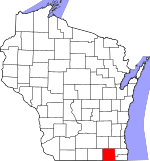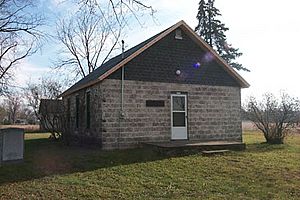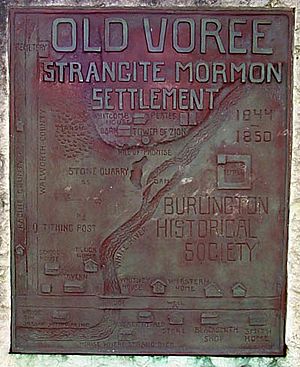Voree, Wisconsin facts for kids
Quick facts for kids
Voree, Wisconsin
|
|
|---|---|
|
Unincorporated Community
|
|

Map of Wisconsin highlighting Walworth County where the unincorporated community of Voree is located
|
|
| Country | United States |
| State | |
| County | Walworth |
| Founded by | James Strang founded Voree in 1844 (independent communal settlement) |
| Named for | Voree means "Garden of Peace" |
| Time zone | CST |
| • Summer (DST) | CDT |
| Area code(s) | 262 |
| Website | www.burlington-wi.gov |
Voree is a small, unincorporated community located in Walworth County, Wisconsin, United States. It is especially known as the main center for the Church of Jesus Christ of Latter Day Saints (Strangite). This is a branch of the wider Latter Day Saint movement. The founder of the Strangite church and the town, James Strang, said that the name Voree means "Garden of Peace." The community is found near where Wisconsin Highway 11 used to be, just west of the Racine County border.
Contents
Voree: A Special Place in Wisconsin

Voree has a long history, even before Europeans arrived, as Native American people lived there. A very important part of Voree's story began in 1844. This was after the death of Joseph Smith Jr., who started the Latter Day Saint movement.
How Voree Began
After Joseph Smith's death, James J. Strang said he was the new leader. He created Voree, which was then part of the Wisconsin Territory. Voree was meant to be a "gathering place" for Latter Day Saints who chose to follow Strang. Other followers chose to follow Brigham Young and moved to the Salt Lake Valley. Young's group later became the Church of Jesus Christ of Latter-day Saints, which is the largest group today.
Life in the Early Voree Community
The "Strangite" church built many strong stone houses, and some of them are still standing. They also had a quarry where they got stone. The community included a blacksmith shop, a place to eat and drink called a tavern, and a school. They even started to build a temple, but they could not finish it.
The church also printed newspapers in Voree, like the Voree Herald and Zion's Reveille. Other businesses in Voree included making gravestones and plows. They also raised English Fox Terrier dogs.
The Voree Plates and Important Beliefs
A small hill in Voree, called the "Hill of Promise," became famous. James Strang said he found three small metal plates there. These plates, called the Voree Plates, were believed to contain an old record. This record became a special book of teachings for Strang's church.
Another practice in Voree was called "Baptisms for the Dead." This was done in the White River, which flowed through the settlement. This practice is still believed in by Strangites today.
Moving to Beaver Island
It became hard for church members to buy land in Voree because prices were high. Also, some leaders disagreed with Strang. Because of these reasons, Strang moved the church's main center to Beaver Island by 1848. Most of his followers went with him.
On Beaver Island, James Strang was seen as a leader, sometimes called the "Mormon king." However, he was attacked in June 1856. He returned to Voree and died a few weeks later. After his death, his followers had to leave Beaver Island. Many of them stopped following his church. But a small group stayed loyal and returned to Voree and nearby areas. The Strangite church still sees Voree as a special gathering place for its members.
Voree Today
The Strangite church is still active in Voree today. There are two different church buildings there, and at least one group meets regularly. There are also other groups of Strangites in different parts of the United States. A monument has been put up in Voree by the historical society from nearby Burlington. This monument remembers the Strangite settlement.



